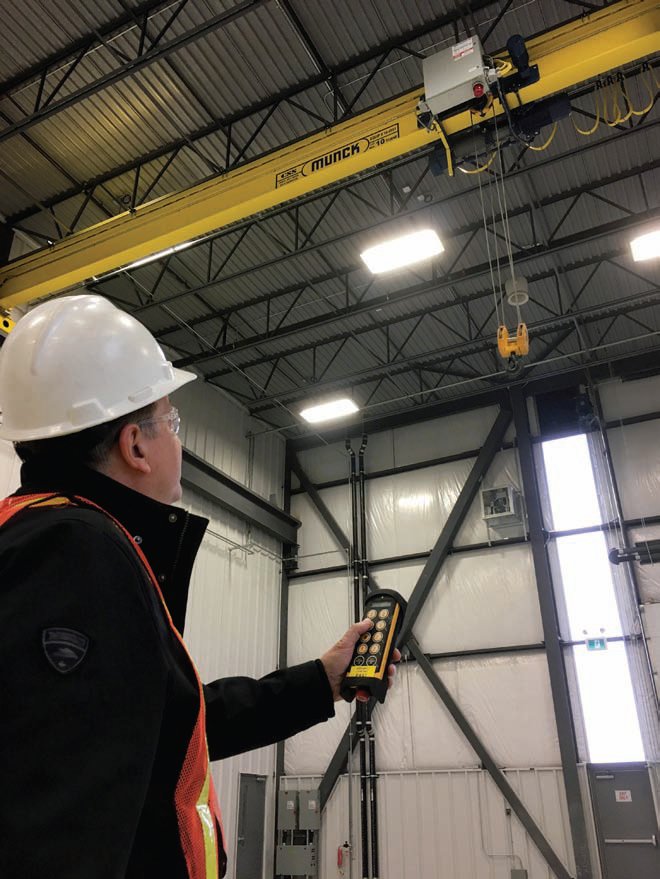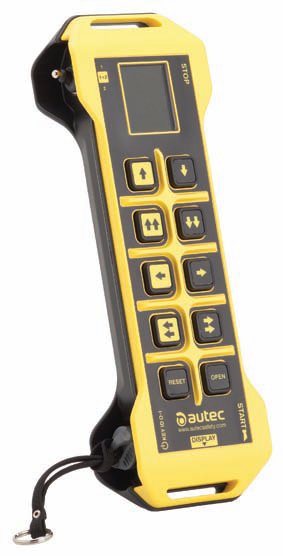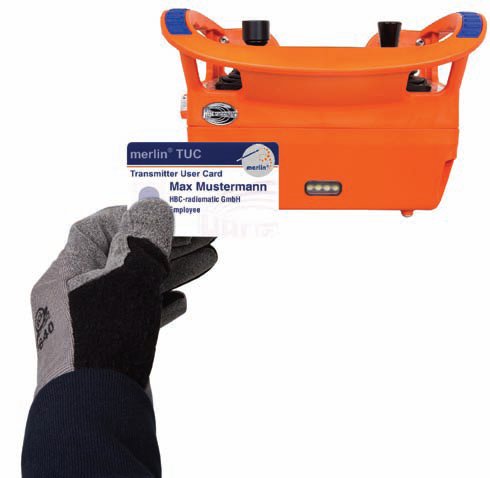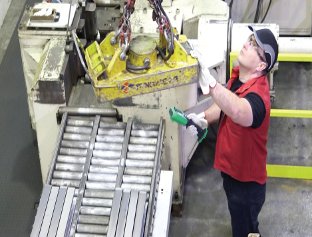Safety is the key
29 June 2017Paola De Pascali spoke with manufacturers to explore the new technologies available in access controls.
Access controls are a feature of some remote controls for overhead cranes, designed to ensure that lifting equipment can’t be accidentally operated. Alain Munoz, application leader for hoisting and material handling at Schneider Electric, explains the reason why access controls are critical to safety in the hoist and crane industry.
“Access controls not only save lives, they can also make crane operations traceable and visible allowing for further management,” says Munoz. “With tight controls, operations can be optimised if necessary, while maintenance and costly repairs can also be mitigated through efficient and predictive maintenance.”
The electric switches in the access gates of the machines, which meet any unauthorised access to crane machinery with an immediate power switch-off, are used across the world. In Europe, this access detection can be classified as a safety-related function in direct compliance with standards ISO13849 or IEC62061, with cranes considered “dangerous machines” by the standards, says Munoz.
“The main difference between European standards and the rest of the world is that in the EU machine manufacturers have to make reliability calculations of all safety functions, like access controls, based on data analytics of the components used,” says Munoz. “In Europe, it is not permitted to determine that a site or machine is safe simply through safety certified components. Instead, designers have to make precise calculations using industry standard tools such as Sistema, which is proposed and managed by IFA. This means that all participants in the design, suppliers, manufacturers, as well as operators on the ground and in the cab share the responsibility for using the machines as defined in design manuals with an acceptable risk level, around the clock.” Munoz adds that in some cases, the machine operations can be monitored through technology embedded within the machine itself. However, this technology remains rare, meaning the usage monitoring still has to be done by the end user.
Talking about the risk of an ‘open access’, unprotected approach, Munoz explains that it could result in overuse of the machinery without constant care and due attention. “With an open policy, the technology would be used much more frequently than the design limitation defined, meaning costly repairs would be required more often than not.
“The buck must stop with the end user who is solely responsible for the usage of the machine. He or she must be sure that access controls are tight and that any operators are identified by official licensing and the adapted training for driving the machine.” Guillem Ramos in Itowa’s marketing department gives an example: “There are situations where two cranes are operating simultaneously, but at some point these two cranes have to handle the same item, and coordinating both cranes is required. “Only one of the transmitters should operate both cranes at the same time to accurately manage cargo. Through access control you can keep the second transmitter from interfering. Access control can activate only one of the transmitters and, even though the second can keep on transmitting data, the receivers won’t pay attention on it.”
TRACKING OPERATORS’ ACCESS
Munoz says the tracking of operators is not done by the machine, but by the users of their own accord.
Nowadays technology in this industry is not developed enough to manage operators’ access, Munoz explains, therefore it remains at the discretion of supervisors on the ground. Though thanks to new innovations, this is likely to change. “The development of industrial ‘Internet of Things’, which connects more and more machines, will lead towards the possibility of having access controls that leverage specialised technology including specific access codes, encrypted passwords and even biometrics such as fingerprints,” says Munoz.
“With these innovations, tracking usage and maintenance can be more efficient than ever before. The companies will have the ability to track who has access the machine, when, why and the actions this individual performed whilst inside the cab. “Some organisations are already taking steps of this nature and making it possible to store such data analysis in ways that are accessible and compiled in a report form, particularly in cloud based platforms. Some big players like Konecranes, Liebherr or Manitowoc are already taking these approaches.”
ACCESS CONTROL SYSTEMS
Munoz says that Schneider Electric has been proposing electromechanical sensors and safety relays to help operators build strong access control and remain compliant. “The company is continuing its innovation and development of all components necessary to build control for industrial and construction cranes,” Munoz adds.
“Today, like many others in the market, Schneider Electric is looking to the future, notably in how technology under industrial ‘Internet of Things’ can help improve access control in the longer term.
“In a major evolution, Schneider Electric has been able to implement electronic controllers inside more and more machines. In the near future the operators are going to expect a more connected environment, which is something that the company will have to satisfy moving forward with this trend.
“Thanks to these electronic controllers, Schneider Electric offers more services than before and has the ability to provide simple, optimum and performance controllers with features capable of collecting data analysis at different levels in real time. This type of innovation and data capture goes a long way to ensure compliance, productivity and most importantly safety with the crane usage improved in the longer term.”
Ramos explains that Itowa has explored at least three different access controls. “We have key control, so only the one with this key can start up the transmitter,” Ramos says. “These are regular keys like those used at home or to start a car. This key is very short in order to easily insert its hardware within a device like Combi and others, where space in its interior is always less than needed.
“This hardware is not so complex, it simply consists of a rotating axis, which is activated by the key rotation and ended with three metallic pins, which are soldered to the electric circuit of the device. When the key is rotated, it simply gives electricity to the circuit or takes it away.
“We currently have different kind of keys, depending on each device we use. There is no additional software involved, it is just a physical access control.”
Another Itowa access control involves sequential pushing on transmitters’ buttons, which require a sequential code to allow operators to use the equipment. This access control can be programmed with only one code, or many if required, which can be frequently changed.
Ramos explains there is no need to have additional hardware, only software that Itowa can implement.
“This access control consists of asking the device some sequential conditions,” Ramos says. “These are previously saved and when entered, the device can be started and runs the original and standard software—if the code is not entered, the device remains blocked.”
Ramos adds that they use their own software with some extra lines of coding and the main advantage is that they can adapt it to fully satisfy the customers’ needs and demands.
“Itowa is currently developing Near Field Communication (NFC) remote controls that work exactly like credit cards or cellphones at payments,” says Ramos. “They get activated when transmitter and receiver get in touch like the trucks’ example above or when a keycard has unlocked the transmitter.”
HBC-radiomatic’s head of product management Jochen Antes explains that the company has several features and technologies available to safely and efficiently protect their radio controls from unauthorised access.
“The unauthorised operation of the transmitter is prevented by using startup procedures that are known to the authorised operator,” says Antes.
“These include the HBC start sequence with a well-defined button sequence, the use of an RFID card, which can be personalised, or PIN entry. In addition, the transmitter can be completely deactivated by removing the Radiomatic iON or Radiomatic iLOG electronic keys. “With Radiomatic Report, we have lately presented an innovative concept which allows both for the protection of the radio control from unauthorised use, and for the tracking of operators’ access. Radiomatic Report includes user identification by Merlin TUC (Transmitter User Card) and, optionally, the HBC data logger.
“The personalised login card Merlin TUC is the key to the radio control. The operator has to hold the card in front of the transmitter for activation. This protects the radio control, and thus the crane, from unauthorised use. At the same time, the card enables the identification of the operator as well as individual card configurations. For example, safety-relevant functions, such as driving into restricted areas, can be unlocked for authorised operators exclusively.
“The HBC data logger can collect a wide range of operational data on the radio control, such as login times of each operator and the operating time of individual drives, down to the exact second,” says Antes. “This makes it very easy to understand how long the radio control has been used by which operators and which functions these operators have used. The data is easily read via Bluetooth interface and is displayed with dedicated PC software, which is included with the delivery. The HBC data logger is available for all HBC radio controls with CAN interface and can also be integrated into existing radio systems with a retrofitting kit.”
Autec’s safety remote control application engineer Diego Zamberlan says: “Operators with different tasks or responsibilities could be limited in using the full set of machine and radio remote control functionalities. This management is particularly useful in industrial lifting and automation applications, especially for overhead crane control.
Zamberlan adds: “The Autec AIR series offer pushbutton and joystick transmitting units to create individual access rights for each user through the information inside an extractable key ID, which contains information to establish the operating mode of the radio control. The key ID can also define some operating functions in order to limit machine operation. Using additional Autec AIR infrared-control (IR) illuminators and receivers, it is also possible to define a specific area from where the machine can be controlled, or just started-up, by the radio control system. When the transmitting unit exits from the control area, the system put the machine in the ‘safe state’.”
Munck Cranes’ electrical department supervisor Murray Chamberlain explains that access control can be implemented in many ways. “The most common would require a key to enable the pendant or radio controls and then, limiting access to the key,” says Chamberlain. “Another option is to check the access to the controls themselves, for example locking a radio remote controller into a cabinet.
“As distributor for Tele Radio controls in Ontario, we have used their software controls which include an enabling pin, through which different operators may have their own access codes, and Radio- Frequency Identification (RFID) access terminals require controls to be authorised by a supervisor to allow the access to restricted travel zones, even by authorised crane operators.”
Munck Cranes installed an access control at Canadian Hydro Components in Ottawa, Ontario, Canada. It allowed access to an area above an office block in the plant only with permission from the supervisor's RFID "key". This was to ensure that no loads could be transported over this area without proper safety precautions being implemented
 As Tele Radio distributor in Ontario, Canada, Munck Cranes installed an access control system at Canadian Hydro Components in Ottawa.
As Tele Radio distributor in Ontario, Canada, Munck Cranes installed an access control system at Canadian Hydro Components in Ottawa.
 Autec’s AIR Series pushbutton and joystick transmitting units make it possible to create individual access rights for each user through the information inside an extractable ‘Key ID’.
Autec’s AIR Series pushbutton and joystick transmitting units make it possible to create individual access rights for each user through the information inside an extractable ‘Key ID’.



